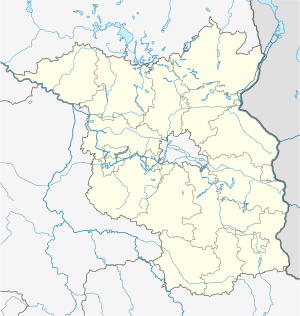Baumgarten Bridge
Coordinates: 52 ° 21 ′ 31 ″ N , 12 ° 57 ′ 46 ″ E
| Baumgarten Bridge | ||
|---|---|---|
| The Baumgarten Bridge, built in 1989 | ||
| use | Street | |
| Convicted |
Bundesstrasse 1 |
|
| Subjugated | Potsdam Havel | |
| place | Schwielowsee / Werder (Havel) | |
| construction | Prestressed concrete bridge | |
| Number of openings | 3 | |
| opening | 1989 | |
| location | ||
|
|
||
The Baumgartenbrücke is a road bridge that leads the Bundesstrasse 1 between Geltow and Petzow over the Potsdamer Havel .
history
Before the first bridge was built, there was a ford, after which there was only a ferry connection across the Havel. The "Great Elector" Friedrich Wilhelm had a 120 meter long wooden bridge built in 1676. It had a device for opening the middle section to enable the ship to pass through. During the reign of the soldier king Friedrich Wilhelm I , there was a customs house and a guardhouse on the east side to prevent the desertion of Prussian soldiers into the Electorate of Saxony , which included the nearby villages of Klaistow, Kanin and Busendorf . The city expansion of Berlin brought the customs station increasing income through the growing shipping traffic that brought bricks from Petzow , Glindow and Rathenow to the royal seat and passed the customs border here. Theodor Fontane dedicated a story to Baumgartenbrück.
“Bomgarden-Brück […] since historical days […] has always been a point of importance, a point whose importance kept pace with the industrial flourishing of the Schwielow and Havel banks. The income increased tenfold, and if earlier a simple, old-fashioned toll had been paid to bring the land travelers dry from one bank to the other, now came the much more lucrative days, where, in addition to the bridge toll for horse and cart, above all also a bridge elevator duty had to be paid for all ships passing through. "
In addition to the local traffic of goods, the stagecoach also crossed this Havel bridge twice a week, because it was on the connecting route between Königsberg and Kleve . During the occupation of Prussia by Napoleonic troops, a military-historical event occurred at the Baumgarten Bridge. On April 28, 1809, Major Ferdinand von Schill bivouacked with his free corpse soldiers of the 2nd Brandenburg Hussar Regiment near the bridge. After Schill's call for a popular uprising against the French occupiers from Prussia, the troops crossed the bridge to fight the French. A boulder with a memorial plaque reminds of this stay.
As a busy section of Reichsstrasse 1, today's Bundesstrasse 1 , the first steel arch bridge spanned the Havel from 1909. In 1910, animal figures by the sculptor Stephan Walter were placed at both ends of the arch . "[...] an otter on the right and a greyhound on the left, from whichever direction you came [...]" ( Festschrift )
After 1945
At the end of the Second World War, on April 30, 1945, soldiers of the Wehrmacht blew up the bridge in order to make the transition more difficult for the approaching Allied troops. After the war , pioneers of the Soviet Army replaced a cable ferry that was temporarily powered by muscle power with a wooden bridge. The temporary structure was removed again in 1950 and the fourth Baumgarten Bridge was built from the still preserved trusses of two other destroyed bridges. However, the animal figures could no longer be erected because they had been dismantled and transported away by Soviet soldiers. The narrow bridge could hardly withstand the growing volume of traffic, especially as its stability was impaired after a tank accident . At the beginning of the 1980s, it was only allowed to drive in one lane with traffic lights. In 1989 it was replaced by a wide, gently curved prestressed concrete bridge. With the help of the state government of Brandenburg, the two sculptures of the otters were returned to their historic location on the eastern bank of the Havel below the bridge on September 6, 1994. The two figures of the greyhounds are missing.
etymology
The word origin of Bomgarde, also Boomgarde , goes back to the Middle Low German term for tree garden, corresponding to orchard .
photos
See also
literature
- Municipal office of Geltow (ed.): Geliti - Geltow. Festschrift: 1000 years of Geltow . Local history considerations, Potsdam 1993.
- Hans-J. Uhlemann: Berlin and the Märkische Wasserstraßen transpress Verlag Berlin various years ISBN 3-344-00115-9
- Writings of the Association for European Inland Shipping and Waterways eV various years. WESKA (Western European Shipping and Port Calendar), Binnenschifffahrts-Verlag GmbH Duisburg-Ruhrort, OCLC 48960431
- Ulrich Scheuermann Field Name Research. Building blocks for home and regional history , Melle 1995 ISBN 3-88368-282-9
cards
- Folke Stender: Editorial team Sportschifffahrtskarten Binnen 1 Nautical publication Verlagsgesellschaft ISBN 3-926376-10-4 .
- Collective of authors: W. Ciesla, H. Czesienski, W. Schlomm, K. Senzel, D. Weidner: Shipping maps of the inland waterways of the German Democratic Republic 1: 10,000, Volume 3 Publisher: Wasserstraßenaufsichtsamt der DDR, Berlin 1988 OCLC 830889996
Web links
Individual evidence
- ^ Fontane: Baumgartenbrück . In: Walks through the Mark Brandenburg
- ↑ A. Herrmann: The Baumgarten Bridge through the ages . In: Festschrift Geltow, 1993, p. 50.
- ↑ Scheuermann, Ulrich, field name research. Building blocks for home and regional history, Melle 1995, p. 111






